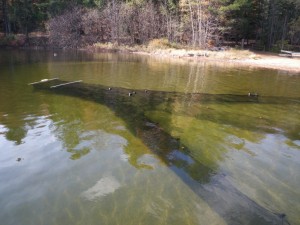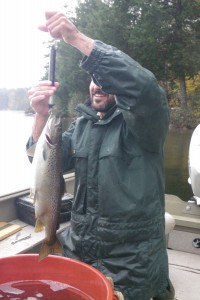October 10, 2012 at 8:56 am
Fall is descending upon us and that means breath-taking foliage, crisp, cool mornings, and trap nets! Trap netting is a live-trapping technique that targets fish swimming close to shore. Maine IFW biologists use them in the fall to sample salmon and trout populations as the fish are heading closer to shore and toward the rivers to spawn.
[caption id="attachment_351" align="alignright" width="300"] A trap net set for salmon and trout. (photo courtesy: Brian Lewis)[/caption]
A trap net works as follows: a single long net is set perpendicular to the shoreline and run straight out toward a deeper section of the body of water. Two other ‘wing’ nets are set at a 45 degree angle from both sides of the end of the first net, pointing towards shore. At the junction of these three nets is a holding area of nets. The overall shape is similar to that of an arrow with the arrow head pointing towards the deeper area of the water and the end of the arrow shaft close to shore. As the fish swim along close to shore, they come upon the original net and swim along the net toward deeper water looking for a way around it. This effectively funnels the fish between the original net and one of the wings where they find a “throat”, or a hole in the nets that lead to a large holding net. Once in the holding area of the nets, they cannot find their way back out and must wait until the net is tended.
Nets are tended 2 or 3 times a week depending upon how many fish are expected to be caught. When the fish are extracted from the holding area they are usually placed in a tub of water that is enhanced with an anesthetic to calm them. The biologists gather biological information such as length, weight, overall health and quality (including noting any hooking injuries, parasites, or other marks), scales for aging and readiness to spawn. A small piece of the tail fin is clipped so biologists will know if the fish is caught again that is a recapture. This piece of fin will grow back within months. The fish are placed in a tub of clean water while they come out of the anesthesia and then released alive back into the water, away from the nets.
[caption id="attachment_415" align="alignright" width="200"]
A trap net set for salmon and trout. (photo courtesy: Brian Lewis)[/caption]
A trap net works as follows: a single long net is set perpendicular to the shoreline and run straight out toward a deeper section of the body of water. Two other ‘wing’ nets are set at a 45 degree angle from both sides of the end of the first net, pointing towards shore. At the junction of these three nets is a holding area of nets. The overall shape is similar to that of an arrow with the arrow head pointing towards the deeper area of the water and the end of the arrow shaft close to shore. As the fish swim along close to shore, they come upon the original net and swim along the net toward deeper water looking for a way around it. This effectively funnels the fish between the original net and one of the wings where they find a “throat”, or a hole in the nets that lead to a large holding net. Once in the holding area of the nets, they cannot find their way back out and must wait until the net is tended.
Nets are tended 2 or 3 times a week depending upon how many fish are expected to be caught. When the fish are extracted from the holding area they are usually placed in a tub of water that is enhanced with an anesthetic to calm them. The biologists gather biological information such as length, weight, overall health and quality (including noting any hooking injuries, parasites, or other marks), scales for aging and readiness to spawn. A small piece of the tail fin is clipped so biologists will know if the fish is caught again that is a recapture. This piece of fin will grow back within months. The fish are placed in a tub of clean water while they come out of the anesthesia and then released alive back into the water, away from the nets.
[caption id="attachment_415" align="alignright" width="200"] A biologist measures the weight of a landlocked salmon caught in a trap net.[/caption]
Using this technique biologists are able to non-lethally sample a variety of waters to ensure the fish are abundant and healthy and to gather data about how many fish are mature and ready to spawn that season. Fish health and readiness to spawn may also be an indicator of habitat and water quality in that body of water. With this information biologists can determine if the management techniques applied to those lakes/ponds/rivers are effective or if something different could and/or should be done to better manage that water body.
A biologist measures the weight of a landlocked salmon caught in a trap net.[/caption]
Using this technique biologists are able to non-lethally sample a variety of waters to ensure the fish are abundant and healthy and to gather data about how many fish are mature and ready to spawn that season. Fish health and readiness to spawn may also be an indicator of habitat and water quality in that body of water. With this information biologists can determine if the management techniques applied to those lakes/ponds/rivers are effective or if something different could and/or should be done to better manage that water body.
 A trap net set for salmon and trout. (photo courtesy: Brian Lewis)[/caption]
A trap net works as follows: a single long net is set perpendicular to the shoreline and run straight out toward a deeper section of the body of water. Two other ‘wing’ nets are set at a 45 degree angle from both sides of the end of the first net, pointing towards shore. At the junction of these three nets is a holding area of nets. The overall shape is similar to that of an arrow with the arrow head pointing towards the deeper area of the water and the end of the arrow shaft close to shore. As the fish swim along close to shore, they come upon the original net and swim along the net toward deeper water looking for a way around it. This effectively funnels the fish between the original net and one of the wings where they find a “throat”, or a hole in the nets that lead to a large holding net. Once in the holding area of the nets, they cannot find their way back out and must wait until the net is tended.
Nets are tended 2 or 3 times a week depending upon how many fish are expected to be caught. When the fish are extracted from the holding area they are usually placed in a tub of water that is enhanced with an anesthetic to calm them. The biologists gather biological information such as length, weight, overall health and quality (including noting any hooking injuries, parasites, or other marks), scales for aging and readiness to spawn. A small piece of the tail fin is clipped so biologists will know if the fish is caught again that is a recapture. This piece of fin will grow back within months. The fish are placed in a tub of clean water while they come out of the anesthesia and then released alive back into the water, away from the nets.
[caption id="attachment_415" align="alignright" width="200"]
A trap net set for salmon and trout. (photo courtesy: Brian Lewis)[/caption]
A trap net works as follows: a single long net is set perpendicular to the shoreline and run straight out toward a deeper section of the body of water. Two other ‘wing’ nets are set at a 45 degree angle from both sides of the end of the first net, pointing towards shore. At the junction of these three nets is a holding area of nets. The overall shape is similar to that of an arrow with the arrow head pointing towards the deeper area of the water and the end of the arrow shaft close to shore. As the fish swim along close to shore, they come upon the original net and swim along the net toward deeper water looking for a way around it. This effectively funnels the fish between the original net and one of the wings where they find a “throat”, or a hole in the nets that lead to a large holding net. Once in the holding area of the nets, they cannot find their way back out and must wait until the net is tended.
Nets are tended 2 or 3 times a week depending upon how many fish are expected to be caught. When the fish are extracted from the holding area they are usually placed in a tub of water that is enhanced with an anesthetic to calm them. The biologists gather biological information such as length, weight, overall health and quality (including noting any hooking injuries, parasites, or other marks), scales for aging and readiness to spawn. A small piece of the tail fin is clipped so biologists will know if the fish is caught again that is a recapture. This piece of fin will grow back within months. The fish are placed in a tub of clean water while they come out of the anesthesia and then released alive back into the water, away from the nets.
[caption id="attachment_415" align="alignright" width="200"] A biologist measures the weight of a landlocked salmon caught in a trap net.[/caption]
Using this technique biologists are able to non-lethally sample a variety of waters to ensure the fish are abundant and healthy and to gather data about how many fish are mature and ready to spawn that season. Fish health and readiness to spawn may also be an indicator of habitat and water quality in that body of water. With this information biologists can determine if the management techniques applied to those lakes/ponds/rivers are effective or if something different could and/or should be done to better manage that water body.
A biologist measures the weight of a landlocked salmon caught in a trap net.[/caption]
Using this technique biologists are able to non-lethally sample a variety of waters to ensure the fish are abundant and healthy and to gather data about how many fish are mature and ready to spawn that season. Fish health and readiness to spawn may also be an indicator of habitat and water quality in that body of water. With this information biologists can determine if the management techniques applied to those lakes/ponds/rivers are effective or if something different could and/or should be done to better manage that water body.Categories